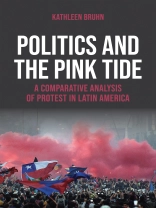Politics and the Pink Tide investigates the ways in which protest varied across five Latin American countries that elected leftist presidents during the Pink Tide.
Kathleen Bruhn compares the differences in protest that occurred under the new leftist governments to their conservative, neoliberal predecessors, offering a wide-angle view into the complex relationships between neoliberalism, political party structures, and protest.
Using individual and event-level data from Bolivia, Brazil, Chile, Venezuela, and Ecuador, Politics and the Pink Tide shows how economic policy choices and the links between leftist parties and social movements affect patterns of protest. For example, although more orthodox neoliberal approaches did motivate more economic protest, the book demonstrates that neither more radical nor more socially linked leftist governments were better able to contain protest—or to do so without resorting to police violence. Politics and the Pink Tide proposes a sweeping exploration of protest, one that is controlled by economic policy and grievances, the social embeddedness of political parties, and the norms surrounding protest tactics within public life.
Tabella dei contenuti
List of Tables and Figures
Introduction: Protest in the Pink Tide
1. Markets and Protest Potential
2. The Ties that Bind: Parties, Representation and Protest
3. Sticks and Stones: Tactical Choices and the Risks of Repression
4. A Crisis of Representation? The Individual Correlates of Protest
5. Flashpoints: Managing Major Episodes of Protest
6. An Interactive Model of Protest
Bibliography
Circa l’autore
Kathleen Bruhn is Professor and Department Chair of Political Science at University of California, Santa Barbara. She is the author of Urban Protest in Mexico and Brazil (Cambridge University Press, 2008).












